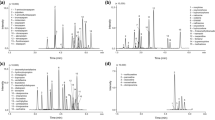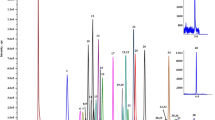Abstract
An ultra-high-performance liquid chromatography–electrospray ionization–tandem mass spectrometry method for the direct analysis in oral fluid (OF) of several abused drugs and metabolites in a single chromatographic run was set up and validated. Amphetamine, methamphetamine, morphine, O-6-monoacetylmorphine, cocaine, codeine, methylenedioxymethamphetamine (MDMA), methylenedioxyethylamphetamine, methylenedioxyamphetamine, methadone, benzoylecgonine (BEG), Δ9-tetrahydrocannabinol (THC), ketamine, and cocaethylene were determined in a single chromatographic run with no sample pretreatment, after addition of the respective deuterated internal standards. The method was designed to perform a confirmation analysis on the residual OF samples after the preliminary on-site screening test, and it was applied on preservative buffers from different devices (Mavand Rapidstat, Concateno DDS, and Greiner Bio-One) or on neat OF samples. The method was suitable to be applied to the small amounts of sample available for the confirmatory analysis after the preliminary on-site screening or on undiluted OF samples. Limits of detection varied from 5 (morphine) to 0.2 ng/mL (methamphetamine, MDMA, BEG, and cocaethylene). The method was linear for all the substances involved, giving quadratic correlation coefficients of >0.99 in all the different preservative buffers checked. In addition, repeatability and accuracy were satisfactory for the majority of the substances, except for a few cases. The developed method was subsequently applied to 466 residual samples from on-site screening performed by police officers. Of these samples, 74 showed the presence of cocaine and metabolites; THC was detected in 49 samples. Two samples showed codeine and morphine while MDMA was detected in 11 samples and ketamine in four samples.




Similar content being viewed by others
References
Drummer OH (2005) Review: Pharmacokinetics of illicit drugs in oral fluid. Forensic Sci Int 150:133–142
Navarro M, Pichini S, Farre M, Ortuno J, Roset PN, Segura J, de la Torre R (2001) Usefulness of saliva for measurement of 3,4-methylenedioxymethamphetamine and its metabolites: correlation with plasma drug concentrations and effect of salivary pH. Clin Chem 47:1788–1795
Spiehler V (2004) Drugs in saliva. In: Moffat AC, Osselton MD, Widdop B (eds) Clarke’s analysis of drugs and poisons. Pharmaceutical Press, London
Huestis MA, Cone EJ (2007) Methamphetamine disposition in oral fluid, plasma, and urine. Ann NY Acad Sci 1098:104–121
Bermejo AM, Lucas AC, Tabernero MJ (2000) Solid-phase microextraction in the determination of methadone in human saliva by gas chromatography-mass spectrometry. J Anal Toxicol 24:93–96
Toennes SW, Steinmeyer S, Maurer HJ, Moeller MR, Kauert GF (2005) Screening for drugs of abuse in oral fluid-correlation of analysis results with serum in forensic cases. J Anal Toxicol 29:22–27
Scheidweiler KB, Spargo EA, Kelly TL, Cone EJ, Barnes AJ, Huestis MA (2010) Pharmacokinetics of cocaine and metabolites in human oral fluid and correlation with plasma concentrations after controlled administration. Ther Drug Monit 32:628–637
Toennes SW, Kauert GF, Steinmeyer S, Moeller MR (2005) Driving under the influence of drugs—evaluation of analytical data of drugs in oral fluid, serum and urine, and correlation with impairment symptoms. Forensic Sci Int 152:149–155
Ramaekers JG, Moeller MR, van Ruitenbeek P, Theunissen EL, Schneider E, Kauert G (2006) Cognition and motor control as a function of Δ9-THC concentration in serum and oral fluid: Limits of impairment. Drug and Alc Dep 85:114–122
Legge 29 luglio 2010, n. 120. Disposizioni in materia di sicurezza stradale. Art. 33: Modifiche agli articoli 186 e 187 e introduzione dell’articolo186-bis del decreto legislativo n. 285 del 1992.
EU Project ROSITA 2. Evaluation of different roadside drug tests. Available at: http://www.rosita.org. Accessed 1st February 2011
DRUID. Driving under the Influence of Drugs, Alcohol and Medicines Integrated Project. Analytical evaluation of oral fluid screening devices and preceding selection procedures. Available at: http://www.druid-project.eu. Accessed 1st February 2011
Speedy T, Baldwin D, Jowett G, Gallina M, Jehanli A (2007) Development and validation of the Cozart DDS oral fluid collection device. Forensic Sci Int 170:117–120
Böttcher M, Preidel A, Beck O (2010) "Peri-analytics" reference ranges for drug screening in oral fluid using the Greiner-Bio-One collection device. In: 48th Annual Meeting of the International Association of Forensic Toxicologists (TIAFT), Bonn (Germany), August, 29th–September 2nd 2010
Laloup M, Ramırez Fernandez MM, Wood M, De Boeck G, Henquet C, Maes V, Samyn N (2005) Quantitative analysis of delta9-tetrahydrocannabinol in preserved oral fluid by liquid chromatography-tandem mass spectrometry. J Chromatogr A 1082:15–24
Øiestad EL, Johansen U, Christophersen AS (2007) Drug screening of preserved oral fluid by liquid chromatography–tandem mass spectrometry. Clin Chem 53:300–309
Wood M, Laloup M, Ramırez Fernandez MM, Jenkins KM, Young MS, Ramaekers JG, De Boeck G, Samyn N (2005) Quantitative analysis of multiple illicit drugs in preserved oral fluid by solid-phase extraction and liquid chromatography–tandem mass spectrometry. Forensic Sci Int 150:227–238
Peters FT, Drummer OH, Musshoff F (2007) Validation of new methods. Forensic Sci Int 165:216–224
Matuszewski BK, Constanzer ML, Chavez-Eng CM (2003) Strategies for the assessment of matrix effect in quantitative bioanalytical methods based on HPLC-MS/MS. Anal Chem 75:3019–3030
Concheiro M, Gray TR, Shakleya DM (2010) M:A: Huestis, High-througput simultaneous analysis of buprenorphine, methadone, cocaine, opiates, nicotine, and metabolites in oral fluid by liquid chromatography tandem mass spectrometry. Anal Bioanal Chem 398:915–924
Concheiro M, de Castro A, Quintela O, Cruz A, Lopez-Rivadulla M (2007) Confirmation by LC-MS of drugs in oral fluid obtained from roadside testing. Forensic Sci Int 170:156–162
Teixeira H, Provenca P, Verstraete A, Corte-Real F, Vieira DN (2005) Analysis of Delta9-tetrahydrocannabinol in oral fluid samples using solid-phase extraction and high-performance liquid chromatography-electrospray ionization mass spectrometry. Forensic Sci Int 150:205–211
Concheiro M, de Castro A, Quintela O, Cruz A, Lopez-Rivadulla M (2004) Development and validation of a method for the quantitation of Δ-9tetrahydrocannabinol in oral fluid by liquid chromatography electrospray-mass-spectrometry. J Chromatogr B 810:319–324
Goessaert AS, Pil K, Veramme J, Verstraete A (2010) Analytical evaluation of a rapid on-site oral fluid drug test. Anal Bioanal Chem 396:2461–2468
Sergi M, Bafile E, Compagnone D, Curini R, D’Ascenzo G, Romolo FS (2009) Multiclass analysis of illicit drugs in plasma and oral fluids by LC-MS/MS. Anal Bioanal Chem 393:709–718
Röhrich J, Zörntlein S, Becker J, Urban R (2010) Detection of Δ9-tetrahydrocannabinol and amphetamine-type stimulants in oral fluid using the rapid Stat™ point-of-collection drug-testing device. J Anal Toxicol 34:155–161
Gunnar T, Ariniemi K, Lillsunde P (2005) Validated toxicological determination of 30 drugs of abuse as optimized derivatives in oral fluid by long column fast gas chromatography/electron impact mass spectrometry. J Mass Spectrom 40:739–753
Wille SMR, Raes E, Lillsunde P, Gunnar T, Laloup M, Samyn N, Christophersen AS, Moeller MR, Hammer KP, Verstraete AG (2009) Relationship between oral fluid and blood concentrations of drugs of abuse in drivers suspected of driving under the influence of drugs. Ther Drug Monit 31:511–519
Pehrsson A, Blencowe T, Vimpari K, Impinen A, Gunnar T, Lillsunde P (2010) Performance evaluation of the DrugWipe® 5/5+ on-site oral fluid screening device. Int J Legal Med. doi:10.1007/s00414-010-0493-x
Gjerde H, Mordal J, Christophersen AS, Bramness JG, Mørland J (2010) Comparison of drug concentrations in blood and oral fluid collected with the Intercept® sampling device. J AnalToxicol 34:204–209
Crouch DJ, Walsh JM, Cangianelli L, Quintela O (2008) Laboratory evaluation and field application of roadside oral fluid collectors and drug testing devices. Ther Drug Monit 30:188–195
Laloup M, Ramirez Fernandez MM, Wood M, De Boeck G, Maes V, Samyn N (2006) Correlation of D9-tetrahydrocannabinol concentrations determined by LC-MS-MS in oral fluid and plasma from impaired drivers and evaluation of the on-site Draeger drug test. Forensic Sci Int 161:175–179
Pehrsson A, Gunnar T, Engblom C, Seppa H, Jama A, Lillsunde P (2008) Roadside oral fluid testing: comparison of the results of Drugwipe 5 and Drugwipe benzodiazepines on-site tests with laboratory confirmation results of oral fluid and whole blood. Forensic Sci Int 175:140–148
Acknowledgments
The present work was supported by the Italian “Dipartimento delle Politiche Antidroga,” through the project “TOXTEST.” Special thanks go to the Italian “Dipartimento di Polizia Stradale” and to police officers that performed on-site screening tests and collected OF samples. We are also grateful to Agilent Technologies for its technical support.
Author information
Authors and Affiliations
Corresponding author
Rights and permissions
About this article
Cite this article
Strano-Rossi, S., Anzillotti, L., Castrignanò, E. et al. UHPLC-ESI-MS/MS method for direct analysis of drugs of abuse in oral fluid for DUID assessment. Anal Bioanal Chem 401, 609–624 (2011). https://doi.org/10.1007/s00216-011-5108-y
Received:
Revised:
Accepted:
Published:
Issue Date:
DOI: https://doi.org/10.1007/s00216-011-5108-y




